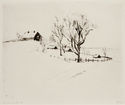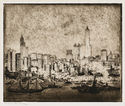
19th, 20th & 21st Century Fine Prints
707-546-7352 · fax 707-546-7924 · web: www.annexgalleries.com · email: artannex@aol.com
Hermann Struck Biography
Hermann Struck
German
1876–1944
Biography
Hermann Struck, also known as Ḥayyim Aharon ben David (Chaim Aaron ben David), was born in Berlin, Germany on March 6, 1876. Struck studied at the Academy of Fine Arts in Berlin with Prof. Max Koner. In 1899, after completing his studies at the Berlin Academy, he was banned from teaching there because he was Jewish. In 1900 he met Jozef Israëls, a Dutch artist, who became his mentor and taught him etching. He became known for his portraits and was commissioned for portraits by Ibsen, Nietzsche, Freud, Albert Einstein, Herzl, Oscar Wilde and other important figures from that period. As a teacher Struck’s students included Marc Chagall, Lovis Corinth, Jacob Steinhardt, Lesser Ury and Max Liebermann. His early work, done in pure etching, was usually signed with his Hebrew name, Ḥayyim Aharon ben David. Marc Chagall learned to etch from Struck during his Berlin period.
Hermann Struck was an avid Zionist and Jewish activist who first visited the land of Israel in 1903, showed his art at the Fifth Zionist Congress, and was one of the founders of the Mizrachi religious – Zionist movement. In 1904, he joined the modern art movement known as the Berlin Secession. In 1908, Struck published “Die Kunst des Radierens” (“The Art of Etching”), which became a groundbreaking work on the subject. It was a textbook that offered both theory and practical instruction. The book was printed on smooth paper and was bound with original etchings by Max Liebermann, Paul Baum, Edvard Munch, Anders Zorn and Herman Struck himself, on veneered paper and with protective sheets.
Struck volunteered for military service in World War I as a translator, liaison officer, and military artist. He received the Iron Cross 1st Class and was promoted to an officer of prowess. in 1917 he became the sponsor for Jewish affairs with the German Eastern Front High Command. The writer Stefan Zweig (1887-1968) spent the last year of the First World War in Lithuania, which was part of the so-called Ober-Ost, the eastern front where the Germans were in charge. Here Zweig met the visual artist Hermann Struck. A lifelong friendship developed between them. Together they made the book “Das ostjüdische Antlitz” (The Eastern jewish Face) because Zweigg got to know Eastern European Judaism in Lithuania and he discovered an “authentic” Judaism that he felt the Jews in the West were losing. He wanted to show this on the basis of Struck’s drawings. “Das ostjüdische Antlitz”, is a book that Arnold Zweig wrote with over 50 drawings by Hermann Struck. The book is a hymn of praise to the Eastern Jews, and it stands out because when the book was published in 1920, many looked down on the Eastern Jews. A few years later they worked together again on “Das neue Kanaan” (The New Caanan).
Struck emigrated to Palestine in 1922, taught at the Bezalel Academy. He helped found the Tel Aviv Museum of Art. He visited Berlin every summer until the Nazis came to power. He was a member of the London Society of Painters, Etchers and Engravers. Herman Struck died in Haifa, Israel on January 11, 1944 at the age of 68.





